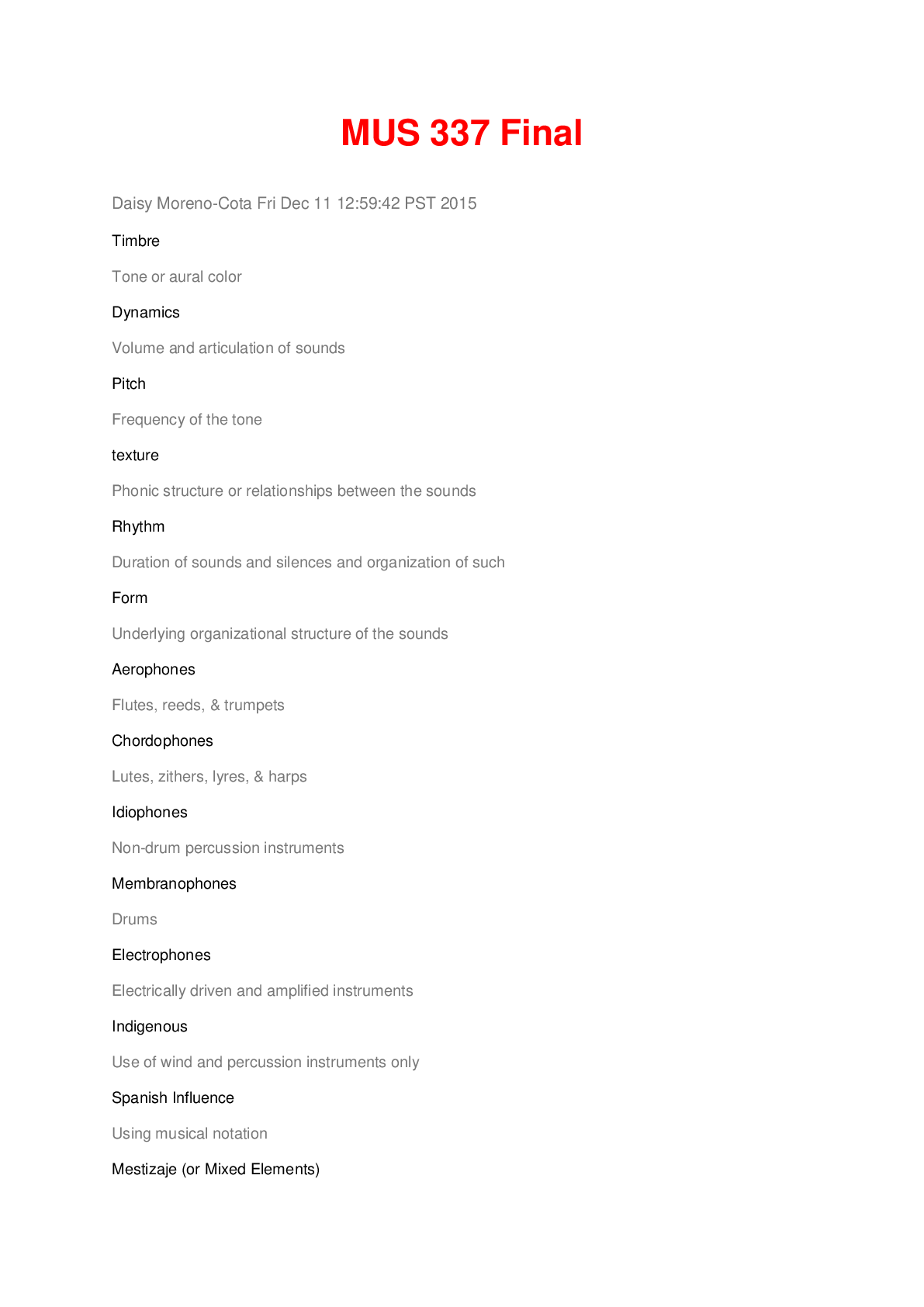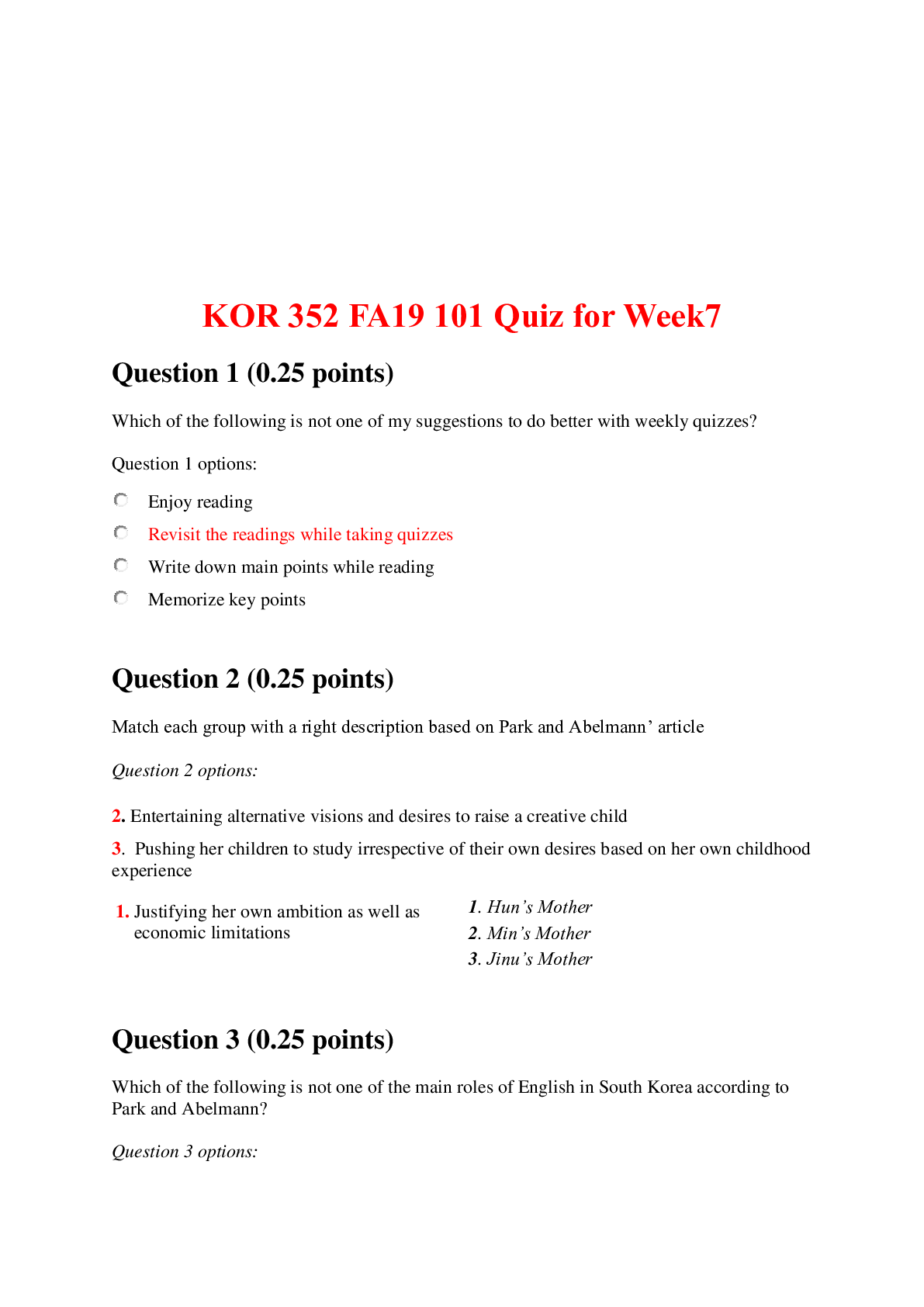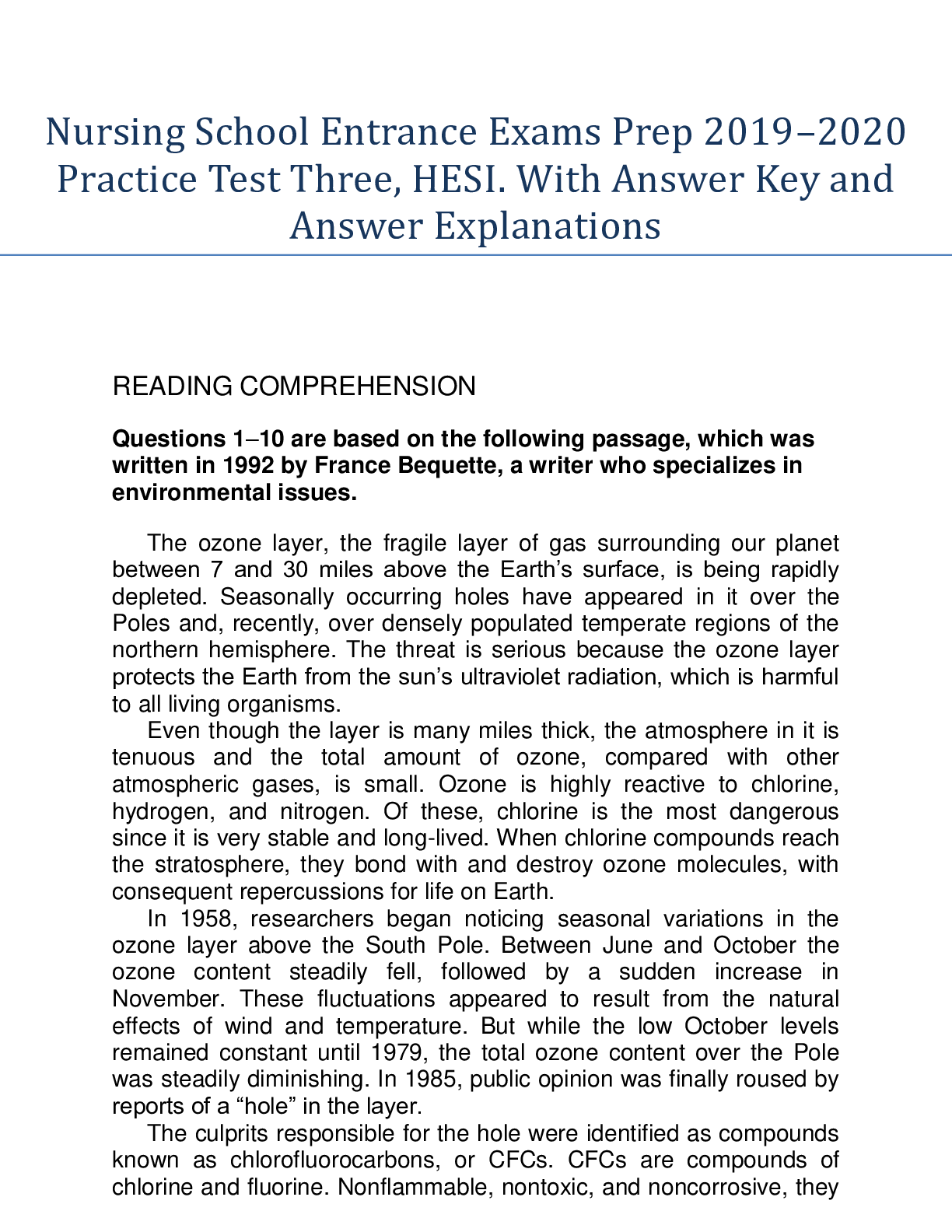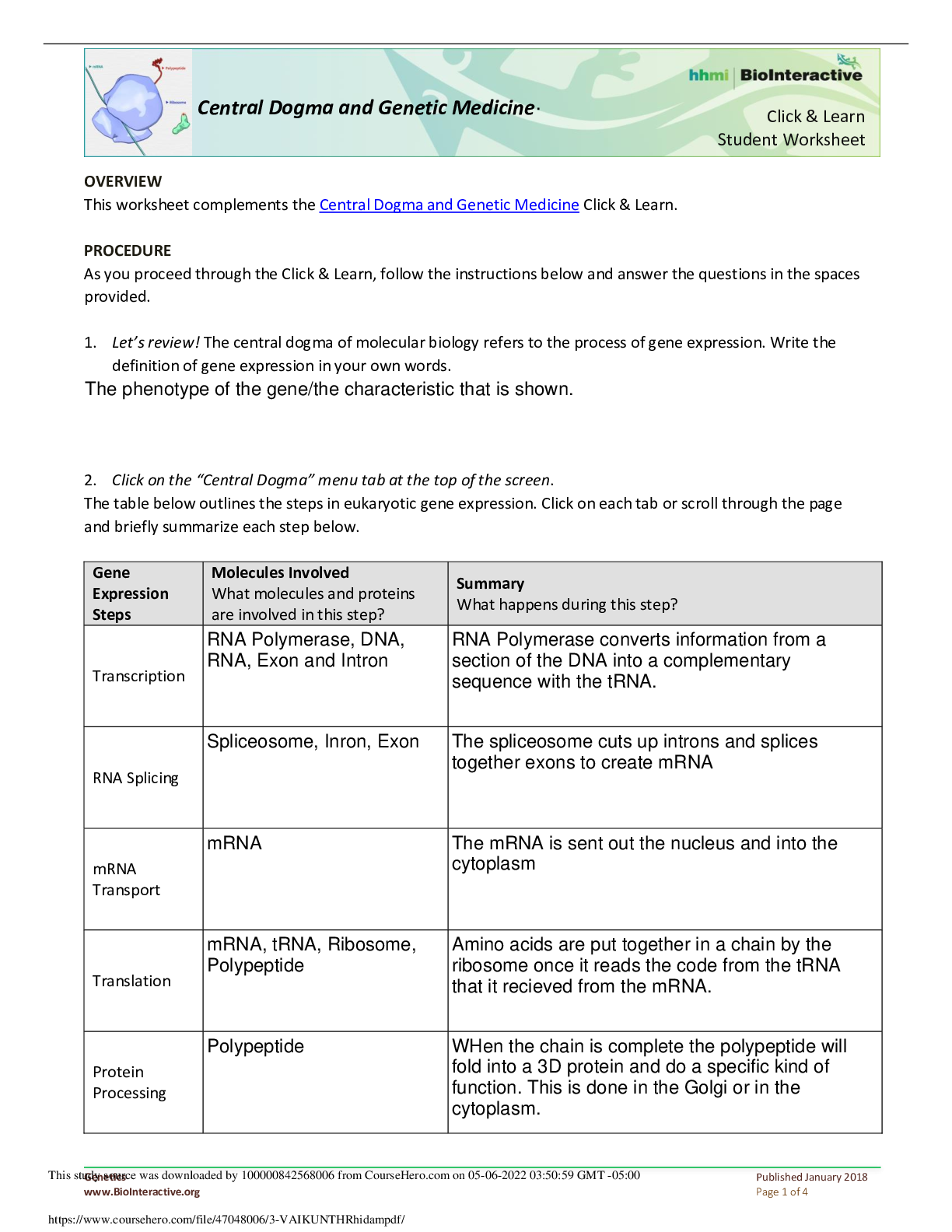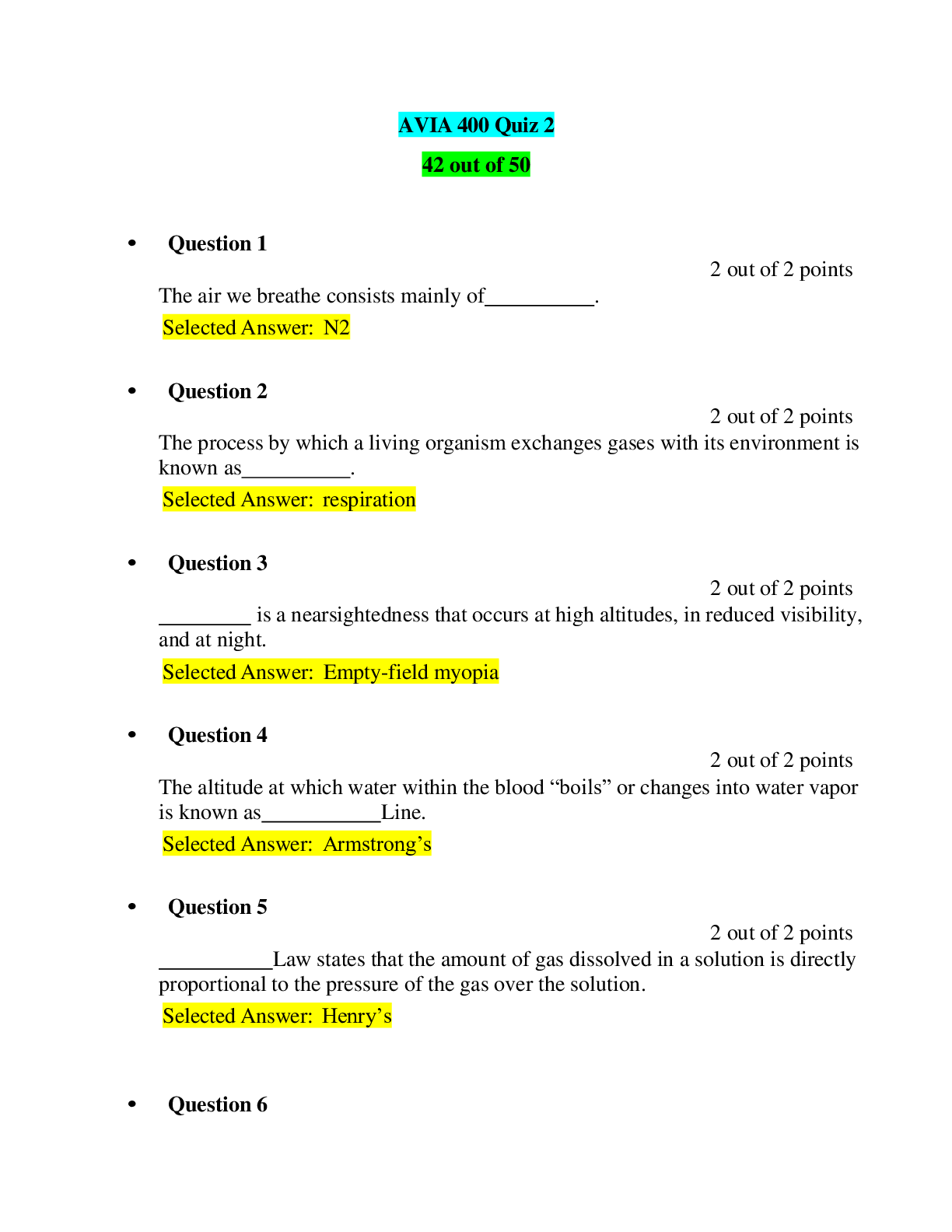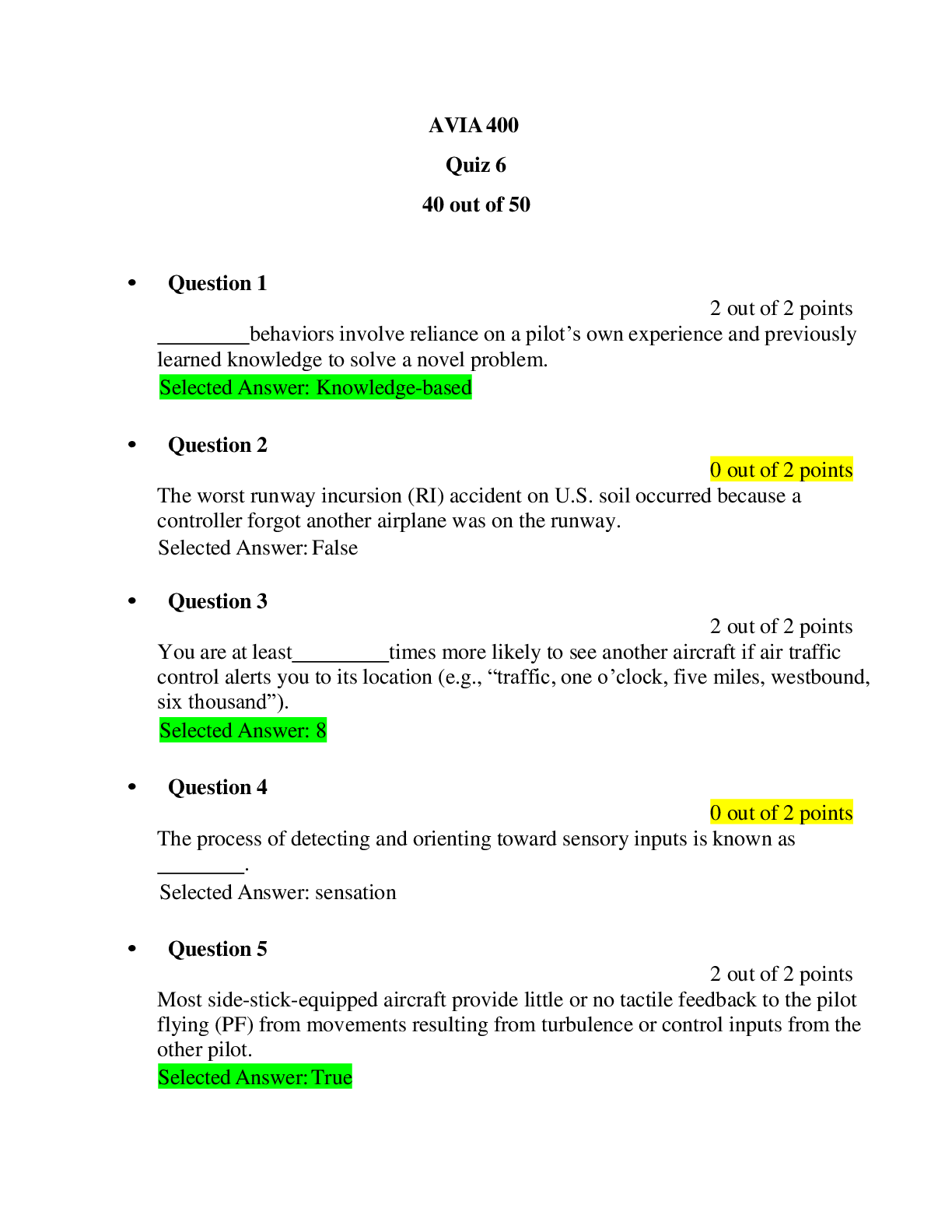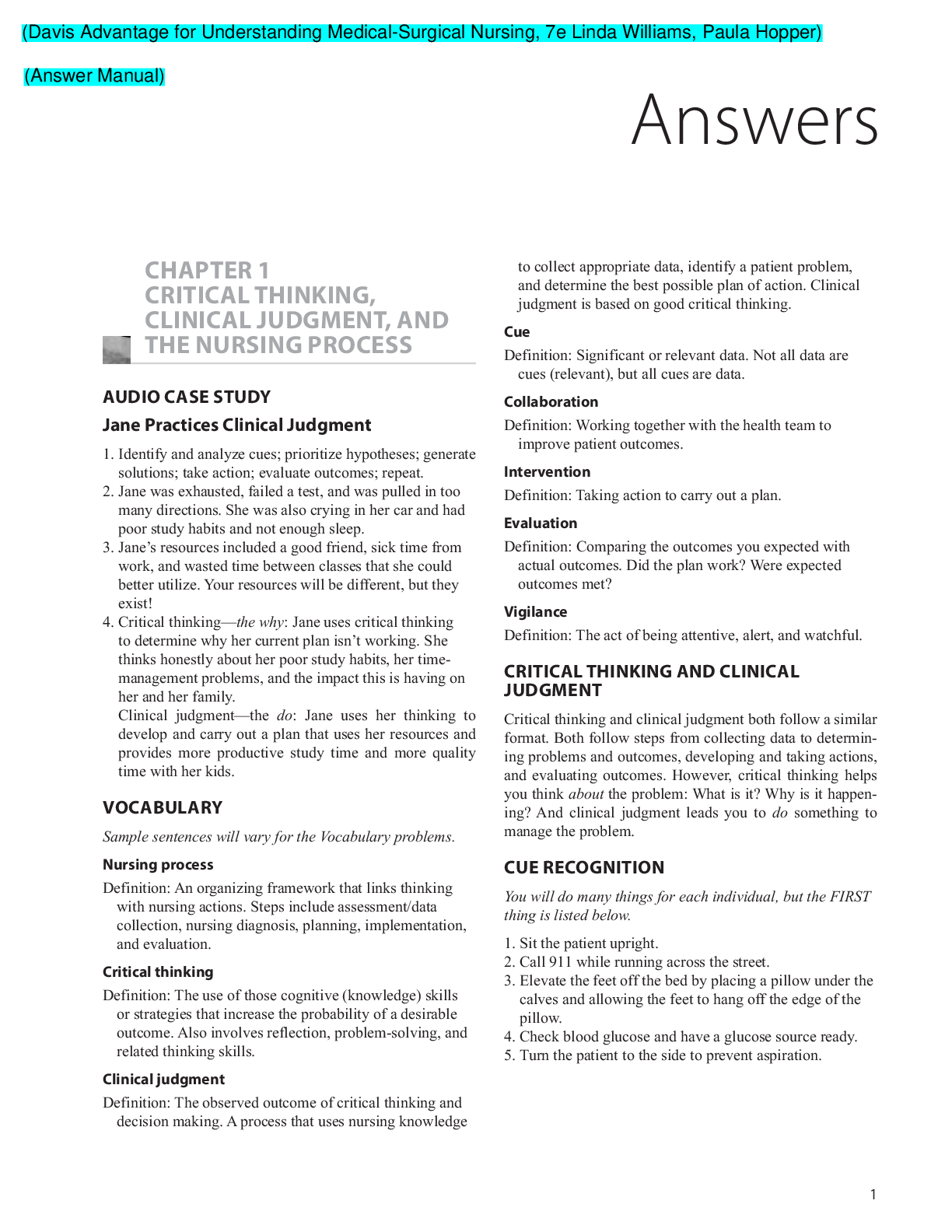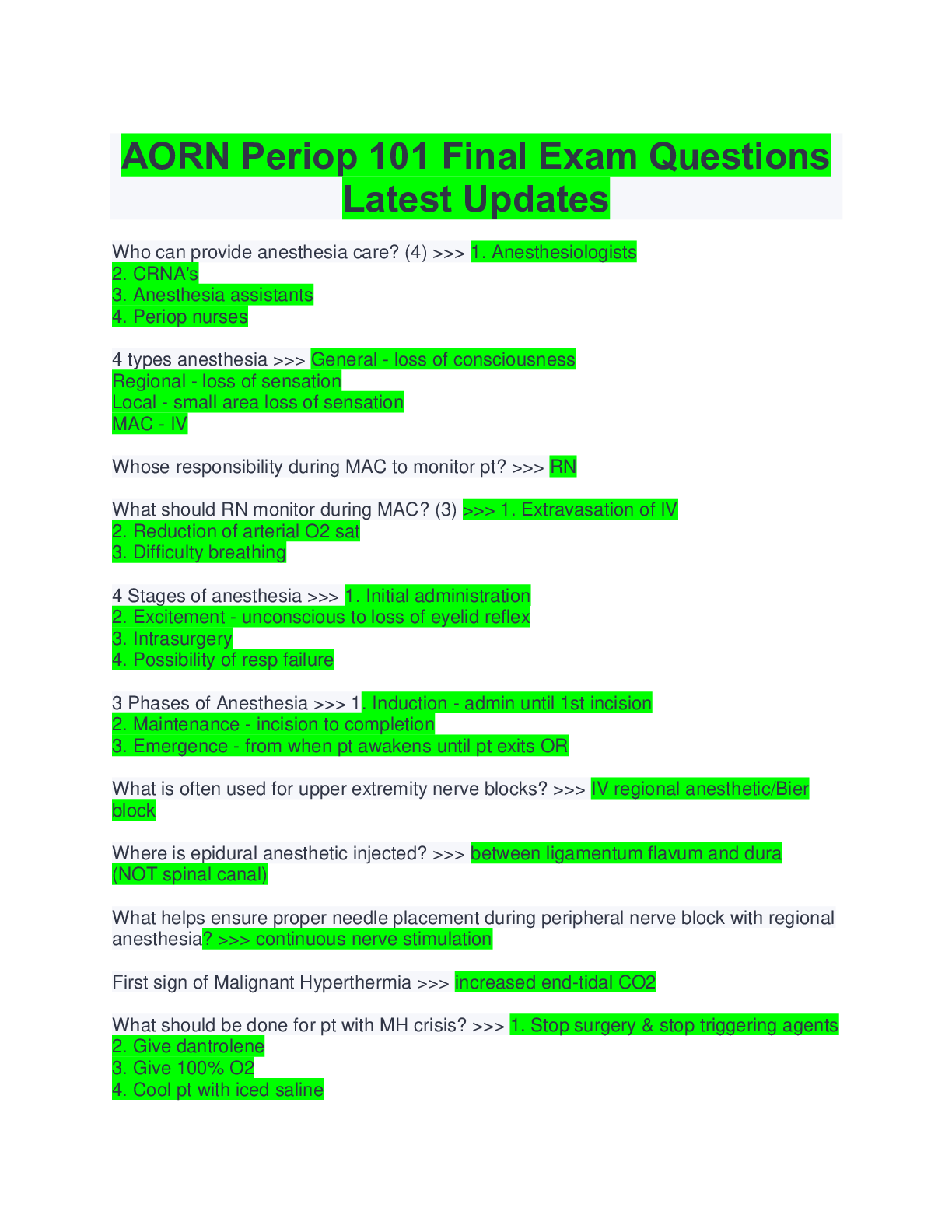Marketing > QUESTIONS & ANSWERS > Chapter 4—Environmental, Regulatory, and Ethical Issues. All Correct Answers (All)
Chapter 4—Environmental, Regulatory, and Ethical Issues. All Correct Answers
Document Content and Description Below
Chapter 4—Environmental, Regulatory, and Ethical Issues TRUE/FALSE 1. Marketing communicators in their various capacities rarely are faced with decisions that have ethical ramifications. :... F PTS: 1 2. For marketing communicators, ethics involves matters of right and wrong, or moral, conduct pertaining to any aspect of marketing communications. : T PTS: 1 3. Especially open to ethical debate is the practice of targeting products and communications efforts to segments that, for various psychosocial and economic reasons, are vulnerable to marketing communications, such as children and economically disadvantaged groups. : T PTS: 1 4. The FTC believes that its authority extends to prohibiting the entertainment industry from targeting children with advertisements for violent films, video games, and music, even if the ads are not deemed deceptive or unfair. : F PTS: 1 5. Billboard advertising of alcohol products is restricted under the Master Settlement Agreement between the federal government and firms in the alcohol industry. : F PTS: 1 6. The FDA regulates the brewing and liquor industries. : F PTS: 1 7. Over 60 percent of advertising is found to be deceptive. : F PTS: 1 8. For subconscious priming to be effective, the primed topic must be compatible with the individual’s current need states. : T PTS: 1 9. One criticism of advertising is that it creates and perpetuates stereotypes. : T PTS: 1 10. The mission of the National Association of Advertising (NAA) is to improve and strengthen the ad agency business, to advocate advertising, to influence public policy, to resist advertising-related legislation that it regards as unwise or unfair, and to work with government regulators to achieve desirable social and civic goals. : F PTS: 1 11. The way firms confront negative publicity has important strategic as well as ethical ramifications. : T PTS: 1 12. Four aspects of packaging that involve ethical issues include label information, packaging graphics, packaging safety, and environmental implications of packaging. : T PTS: 1 13. Slotting allowances require manufacturers to pay retailers a per-store fee for their willingness to handle a new stock unit from the manufacturer. : T PTS: 1 14. Consumers, as well as marketers, can be guilty of unethical behavior in the area of sales promotions. : T PTS: 1 15. Consumer privacy is an ethical issue that trcends all marcom activities. : F PTS: 1 16. The Golden Rule test states that you should take actions that would be viewed as proper by an objective panel of your professional colleagues. : F PTS: 1 17. Regulation is always justified. : F PTS: 1 18. A regulatory disadvantage is increased prices resulting from a reduction in a seller’s “informational market power.” : F PTS: 1 19. Costs of regulation include cost of complying, enforcement costs, and costs resulting from unintended side effects. : T PTS: 1 20. The FTC is the U.S. government agency with primary responsibility for regulating advertising at both the federal and state levels. : F PTS: 1 21. A false claim is, by definition, deceptive. : F PTS: 1 22. According to the FTC, a misrepresentation is said to occur when qualifying information necessary to prevent a practice, claim, representation, or reasonable expectation or belief from being misleading is not disclosed. : F PTS: 1 23. A material representation involves information that is important to consumers and that is likely to influence their choice or conduct regarding a product. : T PTS: 1 24. Unfair advertising is also deceptive advertising. : F PTS: 1 25. Corrective advertising is designed to punish a firm for deceiving consumers. : F PTS: 1 26. The FTC is responsible for regulating information on the packages of food and drug products. : F PTS: 1 27. The National Association of Attorneys General has played an active role in the regulation of marketing communications. : T PTS: 1 28. The advertising clearance process is a form of self-regulation undertaken by ad media that takes place behind the scenes before a commercial or other advertisement reaches consumers. : T PTS: 1 29. AAAA is a self-regulatory group that monitors children’s television programming and commercials. : F PTS: 1 30. The NAD cannot impose fines on deceptive advertisers, but the NARB can. : F PTS: 1 31. Green Seal, a Washington, D.C., nonprofit organization, has developed standards and awarded seals to companies that meet environmental standards. : T PTS: 1 32. Cause-oriented marketing is practiced when companies sponsor or support worthy causes. : T PTS: 1 33. One of the FTC’s guidelines for environmental marketing claims states that “claims should not overstate an environmental attribute or benefit, either expressly or by implication.” : T PTS: 1 34. The major green communications efforts involve advertisements that promote green products, environmentally friendly packaging, seal-of-approval programs that promote green products, cause-oriented communication efforts that support green products, and point-of-purchase display materials that are environmentally efficient. : T PTS: 1 35. In Germany, the White Angel seal represents a promise to consumers that a product carrying an environment claim is in fact legitimate. : F PTS: 1 MULTIPLE CHOICE 1. In a marketing communications context, _____ involves matters of right and wrong, or moral, conduct pertaining to any aspect of marketing communications. a. regulation b. responsibility c. social responsibility d. social awareness e. ethics : E PTS: 1 2. Many critics consider it unethical to market food products to children, especially through practices using cartoon characters to sell sugared cereals and non-nutritious snacks because _____. a. obesity is a major problem with America’s children b. these products are expensive c. children do not have the maturity to make nutritious food choices d. children believe everything they see and hear e. the ads are deceptive : A PTS: 1 3. There is considerable concern regarding the marketing of beer and other alcoholic beverages to teens and young adults. A study by a watchdog group at Georgetown University reported that _____ of alcohol advertising was more likely seen by youths than adults. a. three-quarters b. less than five percent c. seventy percent d. one-half e. one-quarter : E PTS: 1 4. The _____ has issued a regular series of reports, titled Marketing Violent Entertainment to Children, that criticizes the entertainment industry for targeting children with advertisements for violent films, video games, and music. a. FDA b. NAD c. CARU d. FTC e. NARC : D PTS: 1 5. In the past, billboards advertising tobacco and alcohol were disproportionately more likely to appear in _____. a. Southern states b. rural areas c. California d. inner-city areas e. suburban areas : D PTS: 1 6. The regulation of the brewing and liquor industries is done by the _____. a. Federal Trade Commission b. Food and Drug Administration c. Bureau of Alcohol, Tobacco, and Firearms d. National Advertising Division e. National Advertising Review Board : C PTS: 1 7. Target marketing could be considered unethical when the targeting is concerned not with fulfilling consumers’ needs and wants, but rather with exploiting consumers’ _____. a. economic status b. lack of information c. vulnerability d. demographic profiles e. social status : C PTS: 1 8. Which of the following is NOT considered an ethical issue in advertising? a. creates and perpetuates stereotypes b. waste of economic resources c. manipulative d. offensive and in bad taste e. plays on people’s fears and insecurities : B PTS: 1 9. Which of the following statements is true regarding advertising’s manipulative power? a. Bad consumption decisions are proof of advertising’s manipulative power over consumers. b. The only way marketing communications can actually influence consumers is through overt, non-subtle ways. c. A primed goal state generated by advertising remains an active driver of judgments and behavior over the long run. d. Advertising practitioners do not have any ability to influence consumers in very subtle ways. e. People, when consciously aware that attempts are being made to persuade or influence them, have the cognitive capacity to resist efforts to motive them in a direction they wish not to be moved. : E PTS: 1 10. One criticism of advertising that contends that it tends to portray certain groups in very narrow and predictable fashion, or it _____. a. targets economically disadvantaged consumers b. creates and perpetuates stereotypes c. is untruthful and deceptive d. is manipulative e. plays on people’s fears and insecurities : B PTS: 1 11. The organization that promulgated a code of high ethical standards for advertising in 1924, and updated the code in 1990 is the _____. a. Federal Trade Commission b. National Advertising Review Council c. American Advertising Federation d. Children’s Advertising Review Unit e. American Association of Advertising Agencies : E PTS: 1 12. In the AAAA’s Code of Ethical Standards, it is stated that “...we will not knowingly create advertising that contains _____. a. false, or misleading statements or exaggerations, visual or verbal b. statements, suggestions, or pictures offensive to public decency or minority segments of the population c. price claims that are misleading d. testimonials that do not reflect the real opinion of the individual(s) involved e. All of these are correct. : E PTS: 1 13. Ethical issues in packaging can involve _____. a. label information b. packaging graphics c. packaging safety d. environmental implications of packaging e. All of these are correct. : E PTS: 1 14. The practice of marketers in one country using brand names for their products that are virtually the same as the names of established brands from another country is known as _____. a. piracy b. trade dress violation c. private label branding d. ambush marketing e. guerilla branding : A PTS: 1 15. General Mills is introducing a new line of barbecue sauce, and grocery retailers are requiring that General Mills pay them a per-store fee for their willingness to handle the new product. This fee is known as a _____ fee. a. placing b. purchasing c. selling d. slotting e. security : D PTS: 1 16. Who can engage in unethical behavior with respect to sales promotions? a. manufacturers b. retailers c. consumers d. a and b only e. a, b, and c : E PTS: 1 17. _____ is the most important ethical issue that is unique to the online medium. a. Privacy b. Slotting fees c. Negative publicity d. Piracy e. Short filling : A PTS: 1 18. In large part, ethical behavior is a matter of an individual’s _____. a. education b. age c. gender d. income e. integrity : E PTS: 1 19. Jose Ortega acts in a way that he would want others to act toward him. He is using the _____ test. a. utilitarianism b. Golden Rule c. professional ethics d. TV e. moral idealism : B PTS: 1 20. The Golden Rule ethical test states that _____. a. you should take only actions that would be viewed as proper by an objective panel of your professional colleagues b. you would, regardless of the circumstances, always view certain acts or decisions as unethical and others as ethical c. you should act in a way you would want others to act toward you d. you would examine the expected outcome of an act, and if it creates more good than bad, then the act is ethical e. an act is ethical if you would feel comfortable explaining it on television : C PTS: 1 21. According to the _____ test, you should take only actions that would be viewed as proper by an objective panel of your colleagues. a. Golden Rule b. professional ethics c. TV d. moral idealism e. relativity : B PTS: 1 22. Joan works at a major advertising agency and uses the code of ethical standards promulgated by the American Association of Advertising Agencies to guide her in making ethical decisions when developing ads for her agency’s clients. What test is she applying to guide her behavior? a. Golden Rule test b. professional ethics test c. TV test d. peer test e. generally-accepted practices test : B PTS: 1 23. Which of the following is NOT a benefit of regulation? a. Consumer choice among alternatives is improved when consumers are better informed in the marketplace. b. Product quality tends to improve in response to consumers’ changing needs and preferences. c. Unintended side effects are minimized with regulation compared to without it. d. Reduced prices resulting from a reduction in a seller’s “information market power.” e. All of these are benefits. : C PTS: 1 24. Regulation of advertising may result in buyers switching to another product or reducing their level of consumption after regulation is imposed. This is an example of _____ regulation. a. unfair practices b. covert marketing practices c. information regulation in d. unintended side effects of e. Federal Trade Commission : D PTS: 1 25. Regulators have been most active in the area of _____. a. advertising b. personal selling c. sales promotion d. packaging e. publicity : A PTS: 1 26. The _____ is the U.S. government agency that has primary responsibility for regulating advertising at the federal level. a. Food and Drug Administration (FDA) b. National Advertising Review Board (NARB) c. Better Business Bureau (BBB) d. National Advertising Division (NAD) e. Federal Trade Commission (FTC) : E PTS: 1 27. What are the three basic elements of the FTC's current policy determining whether or not an ad is deceptive? a. misleading, reasonable consumer, and material b. misleading, typical consumer, and injury c. comparative ad, misleading, and reasonable consumer d. injury, not avoidable, and material e. injury, reasonable consumer, and false : A PTS: 1 28. Elyssa notices an advertisement with information that is contrary to fact. According to the FTC, this is _____. a. deceptive b. a misrepresentation c. misguided d. material e. unfair : B PTS: 1 29. Campbell’s Soup used glass marbles to displace the chicken, vegetables, and star-shaped noodles in advertisements for it Chicken and Stars soup because, without them, all the solid matter sank to the bottom and consumers couldn’t see the “stars.” The ad was ruled deceptive because Campbell’s did not tell consumers that the soup really did not contain as much meat, vegetables, and noodles as it appeared due to the prop used to photograph the ads. This ad was most likely be considered misleading due to _____. a. immateriality b. hyperbole c. exaggeration d. omission e. unreasonableness : D PTS: 1 30. The FTC’s policy on deception is that the act or practice must be considered from the perspective of a _____. a. reasonable consumer b. probable consumer c. competitor d. government e. child : A PTS: 1 31. A(n) _____ involves information that is important to consumers and that is likely to influence their choice or conduct regarding a product. a. reasonable representation b. material representation c. factual representation d. objective representation e. unfair representation : B PTS: 1 32. What did Kraft state as its defense when the FTC judged the ad for Kraft Singles deceptive? a. The claim made in the ad was not false. b. Reasonable consumers wouldn’t believe the claim regardless of whether it was true or false. c. The claim was merely puffery and did not state a fact. d. The claim was immaterial. e. They agreed the claim made in the ad was false, but other competitors were making the same false claim. : D PTS: 1 33. Jake and thousands of others like him purchased a product advertised on TV that claimed instant hair growth with one application. Jake is representative of the many purchasers of this product in that he is highly sensitive about his recent balding. Because the advertised product is ineffective, the FTC would likely consider this a case of _____ advertising. a. unfair b. deceptive c. unreasonable d. unrepresentative e. unethical : B PTS: 1 34. The criteria used to evaluate whether a business act is unfair involves the consideration of whether the act _____. a. causes substantial injury to consumers, competitors, or other businesses b. offends public policy as it has been established by statutes c. is immoral, unethical, oppressive, or unscrupulous d. a and b only e. a, b, and c : E PTS: 1 35. Which is NOT an element of the definition of unfair advertising? a. an act or practice that causes or is likely to cause substantial injury to consumers b. the injury is not reasonably avoidable by consumers c. misleading from the viewpoint of a reasonable consumer d. not outweighed by countervailing benefits to consumers or competition e. All of the above are elements. : C PTS: 1 36. The XYZ Brewery Corporation undertook an advertising campaign which appeared to encourage pre-legal-drinking-aged teenagers to consume its high-powered malt liquor. The FTC can take action against XYZ on grounds that the advertising campaign is in violation of the _____ doctrine. a. substantiation b. ethics c. unfairness d. responsibility e. deceptive : C PTS: 1 37. _____ is based on the premise that a firm that misleads consumers should have to use future advertisements to rectify the deceptive impressions it has created in consumers’ minds. a. Rectification advertising b. Unfairness removal c. Anti-deception advertising d. Regulated advertising e. Corrective advertising : E PTS: 1 38. The Bamboozle Corporation was finally indicted for years of deceptive advertising. The FTC required the company to spend $5 million on television commercials over the next six months to rectify any deceptive impressions it created in consumers’ minds. In other words, the FTC required Bamboozle Corporation to undertake a(n) _____ program. a. corrective advertising b. rectification c. unfairness removal d. anti-deception e. make-good : A PTS: 1 39. The _____ is the U.S. government agency that has primary responsibility for regulating information on the packages of food and drug products. a. NARB b. NAD c. FTC d. FDA e. BBB : D PTS: 1 40. Advertising of prescription drugs that is directed toward consumers is known as _____. a. direct marketing b. direct-to-consumer advertising c. direct-response advertising d. balanced-perspective advertising e. missionary advertising : B PTS: 1 41. In which country has advertising self-regulation flourished? a. Canada b. France c. United States d. United Kingdom e. All of these are correct. : E PTS: 1 42. The _____ is a form of self-regulation undertaken by ad media that takes place behind the scenes before a commercial or other advertisement reaches consumers. a. ad review process b. advertising clearance process c. NAD review process d. NARB review process e. advertising screening process : B PTS: 1 43. Which of the following is a step in the advertising clearance process? a. advertising agency clearance b. approval from the advertiser’s legal department and perhaps also from an independent law firm c. media approval d. a and b only e. a, b, and c : E PTS: 1 44. The advertising clearance process involves which groups of people? a. advertising agency, advertiser, media, and the audience b. advertiser, FTC, FCC, and FDA c. advertiser, lawyers, NAD, and possibly the NARB d. advertiser, lawyers, FTC, and the NAD e. advertiser, lawyers, advertising agency, and the media : E PTS: 1 45. The self-regulatory monitoring of children’s television programs and commercials is done by the _____. a. FTC b. FDA c. NAD d. CARU e. NARB : D PTS: 1 46. The NAD and NARB were established to _____. a. sustain standards of truth and accuracy in national advertising to adults b. eliminate federal and state regulation of advertising c. uphold standards of taste and decency in national advertising to adults d. punish national advertisers that violate standards of taste and decency in their ads e. punish national advertisers that encourage children to demand products from their parents : A PTS: 1 47. _____ is a court consisting of 50 representatives who are formed into five-member panels to hear appeals of NAD cases when an involved party is dissatisfied with the initial verdict. a. FTC b. CARU c. FDA d. NARB e. NAAG : D PTS: 1 48. NAD is the investigative arm of the _____. a. FTC b. CARU c. FDA d. NARB e. NAAG : D PTS: 1 49. Cases can be brought to the NAD by _____. a. competitors b. NAD staff personnel c. Better Business Bureaus d. consumers e. All of these are correct. : E PTS: 1 50. Some companies have responded to environmental concerns by introducing environmentally oriented products and undertaking marcom programs to promote them. These actions are referred to as ____. a. green marketing b. environmental initiatives c. cause marketing d. clean-world initiatives e. environmental ethics : A PTS: 1 51. Companies have made a number of legitimate responses to environmental problems. They have been motivated for reasons such as achieving regulatory compliance, gaining competitive advantage, and _____. a. being socially responsible b. being profit motivated c. being customer conscious d. being image conscious e. None of these are correct. : A PTS: 1 52. The major green communications efforts include all of the following EXCEPT ____. a. packaging b. sales promotion c. seal-of-approval programs d. cause-oriented communication efforts e. point-of-purchase displays : B PTS: 1 53. Which of the following is NOT a type of green advertising appeal? a. ads that address a relationship between a product/service and the biophysical environment b. those that promote a green lifestyle without highlighting a product or service c. ads that promote short filling, which is the use of less packaging d. ads that present a corporate image of environmental responsibility e. All of these are types of green advertising appeals. : C PTS: 1 54. Research has found that over 40 percent of juice containers, milk cartons, and other dairy products contain a smaller amount of product (from 1 to 6 percent less) than the package labels promise. These are examples of _____. a. mis-labeling b. short filling c. deceptive advertising d. covert marketing practices e. packaging fraud : B PTS: 1 55. Clarence notices the Blue Angel seal on a box of laundry detergent. The Blue Angel seal _____. a. methe product is made in the United States b. methe product is endorsed by the Chamber of Commerce c. represents a promise to consumers that a product carrying an environmental claim is in fact legitimate d. is a sign of approval from the NAD e. represents a promise that the company is an equal opportunity employer : C PTS: 1 56. Green Seal is an eco-labeling program in _____. a. Germany b. Sweden c. Japan d. the United States e. Finland : D PTS: 1 57. The _____ signifies recycled paperboard content. a. semicircle of 10 small arrows b. Blue Angel c. Green Seal d. triangle of three arrows e. rectangle of four arrows : A PTS: 1 58. A number of major corporations, such as General Motors, Amway, and Evian, sponsor or support worthy causes, many of which are environmental causes. Companies are highly motivated to engage in cause-oriented marketing because _____. a. it is a socially acceptable way of distributing excess profits b. corporations function better in a healthy environment c. corporations hope to generate goodwill toward the company and its brands d. major companies are required by law to support environmentally friendly causes e. research shows that companies that support the environment do better financially : C PTS: 1 59. Which of the following is NOT one of the guides for environmental claims promulgated by the Federal Trade Commission? a. Qualifications and disclosures should be sufficiently clear and prominent to prevent deception. b. Claims should not be targeted to children. c. Claims should make clear whether they apply to the product, the package, or a component of either. d. Claims should not overstate an environmental attribute or benefit, either expressly or by implication. e. Comparative claims should be presented in a manner that makes the basis for the comparison sufficiently clear to avoid consumer deception. : B PTS: 1 60. Which of the following is NOT a general recommendation offered to marcom practitioners for making appropriate environmental claims? a. Only make environmental claims that your competitors cannot make. b. Make specific claims. c. Reflect current disposal options. d. Make substantive claims. e. Make supportable claims. : A PTS: 1 61. In the FTC’s Green Guides, claims such as “environmentally friendly” or “safe for the environment” would fall into which of the four general recommendations? a. Make Specific Claims. b. Reflect Current Disposal Options. c. Make Substantive Claims. d. Make Supportable Claims. e. None of these are correct. : A PTS: 1 ESSAY 1. Discuss three ethical issues in advertising. : The chapter covered several ethical issues in advertising, and students can discuss any three of the following: 2. Name and describe three tests marcom professionals can apply to deal with ethical dilemmas. 3. Discuss the costs and benefits of regulation and who pays for or receives each, respectively. When is regulation justified? 4. Compare and contrast the FTC’s deceptive advertising and unfair advertising policies, and give an example of each type of advertisement. 5. Discuss the self-regulation of advertising that occurs before and after an ad appears in the media. 6. Discuss the three types of green advertising appeals and provide an example of each. 7. List and describe the four general recommendations given to marcom practitioners for making appropriate environmental claims. [Show More]
Last updated: 1 year ago
Preview 1 out of 18 pages
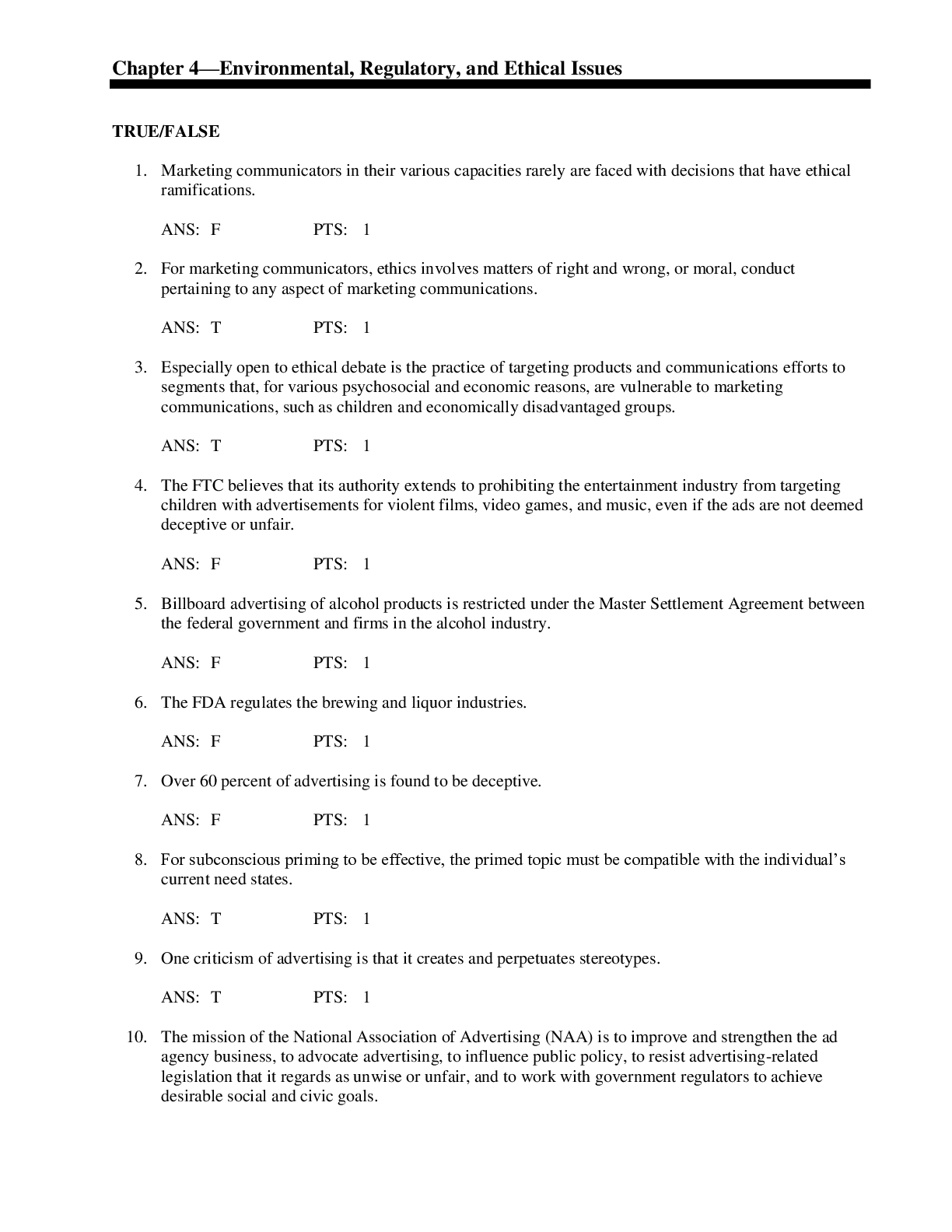
Reviews( 0 )
Document information
Connected school, study & course
About the document
Uploaded On
Nov 06, 2019
Number of pages
18
Written in
Additional information
This document has been written for:
Uploaded
Nov 06, 2019
Downloads
0
Views
60







